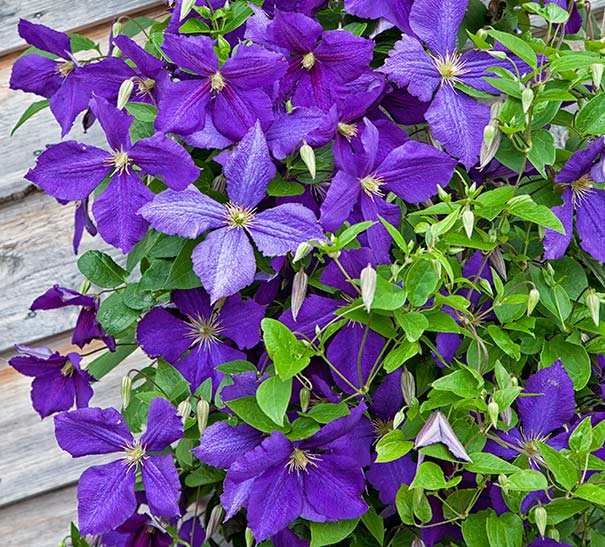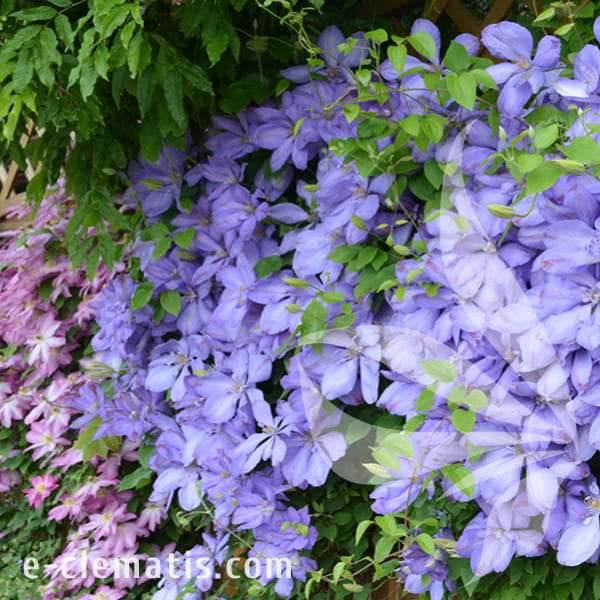How To Grow Bush Clematis For Stunning Blooms
Bush clematis is a beautiful and versatile flowering plant that can add a touch of elegance to any garden. These plants are relatively easy to grow and care for, and they will reward you with stunning blooms for many years to come.
In this blog post, we will discuss everything you need to know about growing bush clematis, from choosing the right location to pruning and deadheading. We will also provide some tips on how to prevent pests and diseases.
Choosing the Right Location
Bush clematis plants prefer full sun or partial shade. They will tolerate some shade, but they will not bloom as well if they do not get enough sunlight. The soil should be well-drained and rich in organic matter. If your soil is not very fertile, you can amend it with compost or other organic matter before planting.
Planting Bush Clematis
Bush clematis plants can be planted in the spring or fall. When planting, dig a hole that is twice the width of the plant's root ball. Backfill the hole with soil, tamping it down gently to remove any air pockets. Water the plant well after planting.
Watering and Fertilizing Bush Clematis
Bush clematis plants need regular watering, especially during the first year after planting. Water the plants deeply once a week, or more often if the weather is hot and dry. In the spring, you can fertilize the plants with a balanced fertilizer.
Pruning Bush Clematis
Bush clematis plants need to be pruned annually to encourage new growth and flowering. The best time to prune is in the spring, before the plant begins to bloom. You can either prune the plant back to about 6 inches from the ground, or you can prune it more lightly to remove any dead or damaged stems.
Deadheading Bush Clematis
Deadheading is the process of removing spent blooms. This will encourage the plant to produce more flowers. You can deadhead bush clematis plants at any time during the flowering season.
Preventing Pests and Diseases
Bush clematis plants are generally resistant to pests and diseases. However, they can be susceptible to aphids, spider mites, and powdery mildew. If you see any signs of pests or diseases, you can treat them with an insecticidal soap or fungicide.
With a little care and attention, bush clematis plants can thrive in your garden for many years to come. These beautiful plants will reward you with stunning blooms that will brighten your landscape for months to come.
Bush clematis is a beautiful and versatile plant that can add color and interest to any garden. It is a shrubby, woody perennial that is native to central Europe, Russia, and China. Bush clematis can grow to be 2-4 feet tall and wide, and it produces large, showy flowers in a variety of colors, including blue, white, pink, and purple. Bush clematis is relatively easy to care for and is hardy in USDA zones 3-8.
If you are interested in learning more about bush clematis, please visit Home Gardening. This website has a wealth of information about bush clematis, including planting instructions, care tips, and a variety of cultivar listings. You can also find photos of bush clematis in bloom, as well as helpful articles about how to choose the right bush clematis for your garden.
FAQ of bush clematis
- What is bush clematis?
Bush clematis is a type of clematis that does not climb. It has an upright, spreading habit and can grow up to 3 feet tall and wide. Bush clematis is known for its showy flowers, which can be white, pink, blue, or purple.
- What are the growing conditions for bush clematis?
Bush clematis prefers full sun to partial shade and well-drained soil. It is not fussy about pH, but it does appreciate a soil that is rich in organic matter. Bush clematis is drought-tolerant once it is established, but it should be watered regularly during the first year after planting.
- How do I plant bush clematis?
Bush clematis can be planted in the spring or fall. When planting, dig a hole that is twice as wide and as deep as the root ball. Amend the soil with compost or other organic matter. Place the plant in the hole and backfill with soil, tamping down gently. Water well.
- How do I care for bush clematis?
Bush clematis is a relatively easy plant to care for. Water it regularly, especially during the first year after planting. Fertilize it once a year in the spring with a balanced fertilizer. Deadhead spent flowers to encourage more blooms. Prune bush clematis in the spring, just before new growth begins.
- What are some common pests and diseases of bush clematis?
Bush clematis is susceptible to a few pests and diseases, including aphids, spider mites, powdery mildew, and clematis wilt. Aphids and spider mites can be controlled with insecticidal soap or neem oil. Powdery mildew can be prevented by watering the plant in the morning so that the leaves have a chance to dry before nightfall. Clematis wilt is a serious disease that can kill the plant. If you suspect that your plant has clematis wilt, it is important to remove it from your garden and destroy it.
- How long does bush clematis live?
Bush clematis can live for many years with proper care. With regular pruning, it can be kept to a manageable size and will continue to bloom for many years to come.
Image of bush clematis
10 different images of bush clematis that are free to use:
- Clematis armandii is a deciduous clematis that produces fragrant, white flowers in the spring. It is a vigorous grower and can reach up to 10 feet tall.

- Clematis montana is an evergreen clematis that produces small, white flowers in the spring and summer. It is a fast-growing climber and can reach up to 30 feet tall.

- Clematis viticella is a deciduous clematis that produces large, purple flowers in the summer. It is a vigorous grower and can reach up to 15 feet tall.

- Clematis texensis is a deciduous clematis that produces small, blue flowers in the spring and summer. It is a low-growing clematis and is often used as a groundcover.

- Clematis macropetala is a deciduous clematis that produces large, pink flowers in the summer. It is a vigorous grower and can reach up to 10 feet tall.

- Clematis x jackmanii is a hybrid clematis that produces large, red flowers in the summer. It is a vigorous grower and can reach up to 20 feet tall.

- Clematis Nelly Moser is a hybrid clematis that produces large, purple flowers with white edges in the summer. It is a vigorous grower and can reach up to 15 feet tall.

- Clematis Mrs. Cholmondeley is a hybrid clematis that produces large, white flowers with pink edges in the summer. It is a vigorous grower and can reach up to 15 feet tall.

- Clematis armandii var. grandiflora is a variety of Clematis armandii that produces larger, more fragrant flowers than the species plant. It is a vigorous grower and can reach up to 10 feet tall.
- Clematis texensis var. texensis is a variety of Clematis texensis that produces larger, bluer flowers than the species plant. It is a low-growing clematis and is often used as a groundcover.

Post a Comment for "How To Grow Bush Clematis For Stunning Blooms"